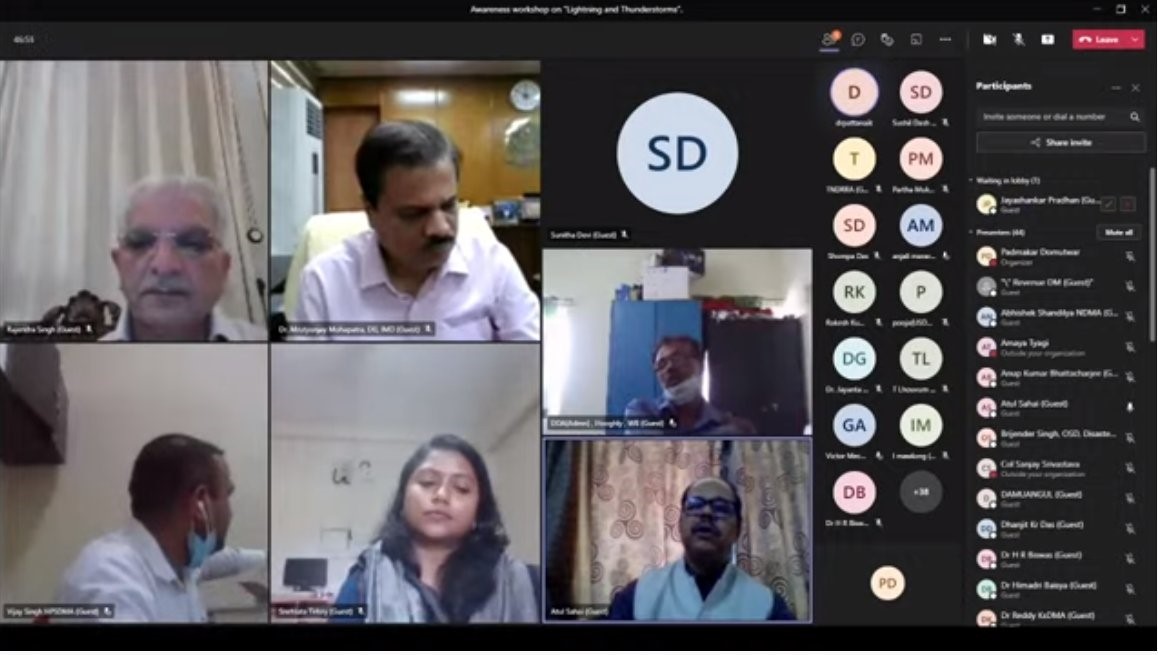Ministry of Earth Sciences
An awareness session-cum-workshop on mitigating hazards due to lightning and thunderstorms by creating last mile connectivity
Thunderstorm, accompanied by lightning is the single largest killer natural disaster in India: Member, NDMA
India is among a few countries which has introduced a Lightning Warning System: DG, Indian Meteorological Department
प्रविष्टि तिथि:
28 JUN 2021 7:44PM by PIB Mumbai
Mumbai, 28 June 2021
In India, over the recent years, there's an increasing trend in death-toll and damages reported due to lightning. Thunderstorm, accompanied by lightning is the single largest killer natural disaster in India, causing more than 2000 deaths every year, stated Rajendra Singh, Member of National Disaster Management Authority in an awareness workshop today. Lightning and thunderstorm causes widespread loss every year, despite the improved understanding, monitoring, and prediction capability brought about by scientific and technological progress. The reason for this has been identified by experts as a communication gap which does not result in last mile connectivity. In order to address this issue, the Indian Meteorological Society along with Indian Institute of Tropical Meteorology (IITM), Indian Meteorological Department (IMD) and the National Centre for Medium Range Weather Forecasting (NCMRWF) organized the workshop-cum-awareness session on lightning forecast and warning dissemination, for media and state-level disaster managers from Maharashtra, West Bengal, Odisha, Kerala, Bihar, UP and other parts of the country. The experts who participated in the workshop also included Director-General of IMD Dr. M. Mohapatra, Vice-President of Indian Meteorological Society Dr. A.K. Sahai, Secretary of Indian Meteorological Society Dr. D.R. Pattanaik and senior scientists from the Ministry of Earth Sciences.
Community-involvement in implementing NDMA’s Guidelines
Shri Singh, Member of NDMA, further stated, loss of human lives and properties due to lightning is significantly high - it is more than that of people killed in tornadoes or hurricanes globally. Economic losses like that of cultivated fields and buildings occur, infrastructure like communication networks, power plants and so on are often destructed by lightning events and sometimes, lightning and thunderstorms may ignite potentially devastating wildfires, he stated. He advised, "It is highly important that we pay attention to the safety precautions so as to avoid lightning disasters. By adhering to personal safety guidelines and keeping a watch on weather-warnings, we can protect ourselves to a great extent". He informed that NDMA has issued detailed guidelines on action-plan by state and local authorities. "These guidelines drawn from international best practices, provide do-s and don't-s as well as steps to be taken by common people". He also said, "Participation of stakeholders including NGOs and civil society towards implementation of NDMA's guidelines with a community-centric approach would help in improving state's response effectively to mitigate the adverse effect of these incidents". In pre and post-monsoon season, NDMA conducts workshops with all stakeholders to discuss preparedness and mitigation measures for reducing the impact of thunderstorms & lightning, dissemination of early warnings at local level, SOPs and so on. NDMA also works on improving inter-agency coordination which includes monitoring and reviewing mechanism at field-level, forecasting and dissemination of nowcast warnings of IMD, checking on the status of public awareness and community outreach, preparation of IEC materials and posters in local languages.

Need of the hour in reaching out to people with IMD’s services
Dr. Mohapatra, DG, IMD said, Lightning has become a serious threat in recent years. This is due to, primarily increased exposure of people, especially farmers, fishermen and labourers who remain outside for reasons of livelihood, he opined. Further, technological advancement has increased the numbers of electrical objects, instruments and devices in our vicinity, he added." At the same time, there has been significant improvement in our capabilities to monitor, predict and warn the people", he added. India is among a few countries which has introduced a Lightning Warning System, informed DG, IMD. He stated that the joint initiative taken by scientists of IITM, IMD and NCMRWF in 2018 had led to the development of a Lightning Warning System having a location-specific forecast upto 48 hours about the occurrence of thunderstorms, lightning, squally winds, gusty winds, hailstorms. This apart, IMD has about 30 radars in the country, which help to provide weather information in every 10 mins. Besides, ISRO is providing satellite information from INSAT-3DR about convective clouds, which is uploaded every 15 mins. We are also capable of having real time information about lightning updated in every 5 mins, added the weather-scientist. The models developed by Ministry of Earth Sciences, on real-time, are very definite and are utilized by forecasters. Information is provided in every three hours for each and every district of the country. Damini App provides location specific information which remains valid for every half an hour, informed Dr. Mohapatra. "We also have very location-specific information for 1085 stations spread across the country. We are going to increase that number so that we can reach-out to every block and sub-blocks at the panchayat level", stated Dr. Mohapatra. Stating this, DG, IMD observed that though services have augmented, the need of the hour in reaching out to people is to have more collaboration with those who can extend the services of IMD to common man right upto the last mile. "In this, media and state-level disaster management authorities play a significant role", he stated.
Systematic approach in managing the risks is the key
Informing that today is International Lightning Safety Day and that the last week was observed as National Lightning Safety Awareness Week, Vice-President of the Indian Meteorological Society, Dr. A. K. Sahai stated that damages due to natural hazards has shown a growing trend in recent years and climate change may make such events even more dangerous. "A systematic approach in managing the risks associated with these disasters can prevent or mitigate their impact", he said. He observed that IMD's timely weather-warnings need to reach out to people at remote corners. In this context, he informed that NDMA has constituted an expert committee to develop a protocol on early warning and forecasting dissemination on thunderstorms and lightning.
In the technical session, Col.(Retd.) Sanjay Srivastava highlighted a community centric outreach programme called ' Lightning Resilient India Campaign' has been initiated by initiative of Climate Resilient Observing-Systems Promotion Council (CROPC) with support from NDMA, IMD, Union Ministry of Earth Sciences, Indian Meteorological Society among other stakeholders.
****
DJM/SC/DR
Follow us on social media:  @PIBMumbai
@PIBMumbai  /PIBMumbai
/PIBMumbai  /pibmumbai
/pibmumbai  pibmumbai[at]gmail[dot]com
pibmumbai[at]gmail[dot]com
(रिलीज़ आईडी: 1730978)
आगंतुक पटल : 1116